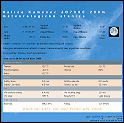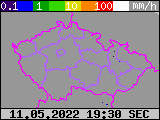|

Vydáno dne 07. 01. 2011 (7585 přečtení) |
|||||||||||||||||||||||||||||||||||||||||||||||||||||||||||||||||||||||||||||||||||||||||||||||||||||||||||||||
 |
přepnout na verzi v češtině |
Libor found a schematic of the converter on the Internet (The author is Roger G3XBH). I provided him with the key parts and Libor homebrewed it during one afternoon. We have used a crystal with frequency of 10 MHz. The oscillator oscillates a little bit higher, but for this use it is not important.
We met in the radio-club's ham-shack on the evening before Christmas Eve. We connected an antenna inverted V (twice 40m at a height of about 15 meters) to the input of the converter and its output to the short wave transceiver. The antenna is, due to the wavelength of the transmitted signal, desperately short and low. But this would be the case of any antenna that we can afford. We were able to receive quite decently several digital, synchronising and timing signals in the range of about 10 to 25 kHz. So, it seemed that the configuration of antenna-converter-transceiver worked pretty well.
| Converter by Roger, G3XBM | Libor's OK1HDF version | Converter + K3 |
We met again in the radio-club at around 7:00 UTC, 24th of December. We again connected everything together, tuned to the frequency of 17.2 kHz and waited to see, whether something appeared. At first we used the TRX K3. In case of success we were prepared to make a recording using a laptop with cable to the microphone input. At approximately 7:45 UTC there appeared a surprisingly strong signal. We expected a weak signal fading in noise. The reality was much better than we had imagined. The S-meter showed a strength of 7 to 8, and with almost no interference. The frequency fluctuated negligibly (probably the speed of generator drops slightly, when it is keyed), but otherwise the signal was very stable. The display of the radio showed a frequency of 10017.45 kHz, but it was because of the inaccurate frequency of the oscillator in the converter. Initially there was some chaotic keying, but in few minutes it changed to the regular repetition of "VVV DE SAQ" over and over again. This can be heard on the first recording, which was made using K3 with IF width set to 150 Hz.
| Libor is searching through the VLF band | Converter + FT-857 | Transcript of a message from Sweden |
Then there were a few seconds of silence, so we decided to connect the converter to Libor's FT-857. It took us a while, so we missed the beginning of the main message. Reception using this radio was again very good and clean. During this recording the width of the filter was set to 240 Hz. The last picture shows approximate transcript of the message from Sweden, which I have taken down for those who are not able to understand Morse code.
And finally, here are those mentioned recordings. The size of the first mp3 file is about 5.3 MB and takes something over 5 minutes. (A bit boring, because it repeats over and over the same text.) The second one is about 6.5 MB and takes almost 7 minutes. During the recording of the second file, we were taking the signal from the loudspeaker output of the FT-857. The loudspeaker worked partially as a microphone, so you can hear our voices in background.
Libor OK1HDF: Homebrewed the converter and tuned the radio.
Jarda OK1HDU: Made those audio files and wrote this article.
VLF converter for listening to the SAQ Grimeton station at 17.2 kHz (05.02.2019)
VLF konvertor pro poslech stanice SAQ Grimeton na kmitočtu 17,2 kHz (04.02.2019)
Nová Vánoční tradice: Poslech VLF stanice SAQ Grimeton. (24.12.2018)
Vánoční vysílání SAQ Grimeton (24.12.2012)
Mimořádná relace SAQ Grimeton ke dni OSN (24.10.2012)
Mimořádné vysílání Grimeton radio/SAQ (06.08.2011)
QSL od SAQ (12.02.2011)
The VLF converter once more (08.01.2011)
VLF konvertor ještě jednou. (05.01.2011)
Poslech SAQ na vlně 17.44 km (24.12.2010)
| Novinky |
|
07.07.2023: Update na webu DXFC Dneska jsem updatoval info na webu DXFC.
05.07.2019: Update fotoalba Do fotoalba jsem přidal pár fotografií ze:
Slovinska (červen 2019) Fotoalbum prozatím zrušeno. 05.12.2018: Update fotoalba Do fotoalba jsem přidal pár fotografií ze:
Slovinska (jaro 2018) a ze: Suchého Vrchu (zima 2005/2006). Fotogalerie je prozatím zrušena. |
| kalendář |
| |||||||||||||||||||||||||||||||||||||||||||||||||
| Radary ČHMU |
|
|
| Zaparkováno na: |

|
| TSL certifikát: |

|
Tento web site byl vytvořen prostřednictvím phpRS - redakčního systému napsaného v PHP jazyce.
Na této stránce použité názvy programových produktů, firem apod. mohou být ochrannými známkami
nebo registrovanými ochrannými známkami příslušných vlastníků.























